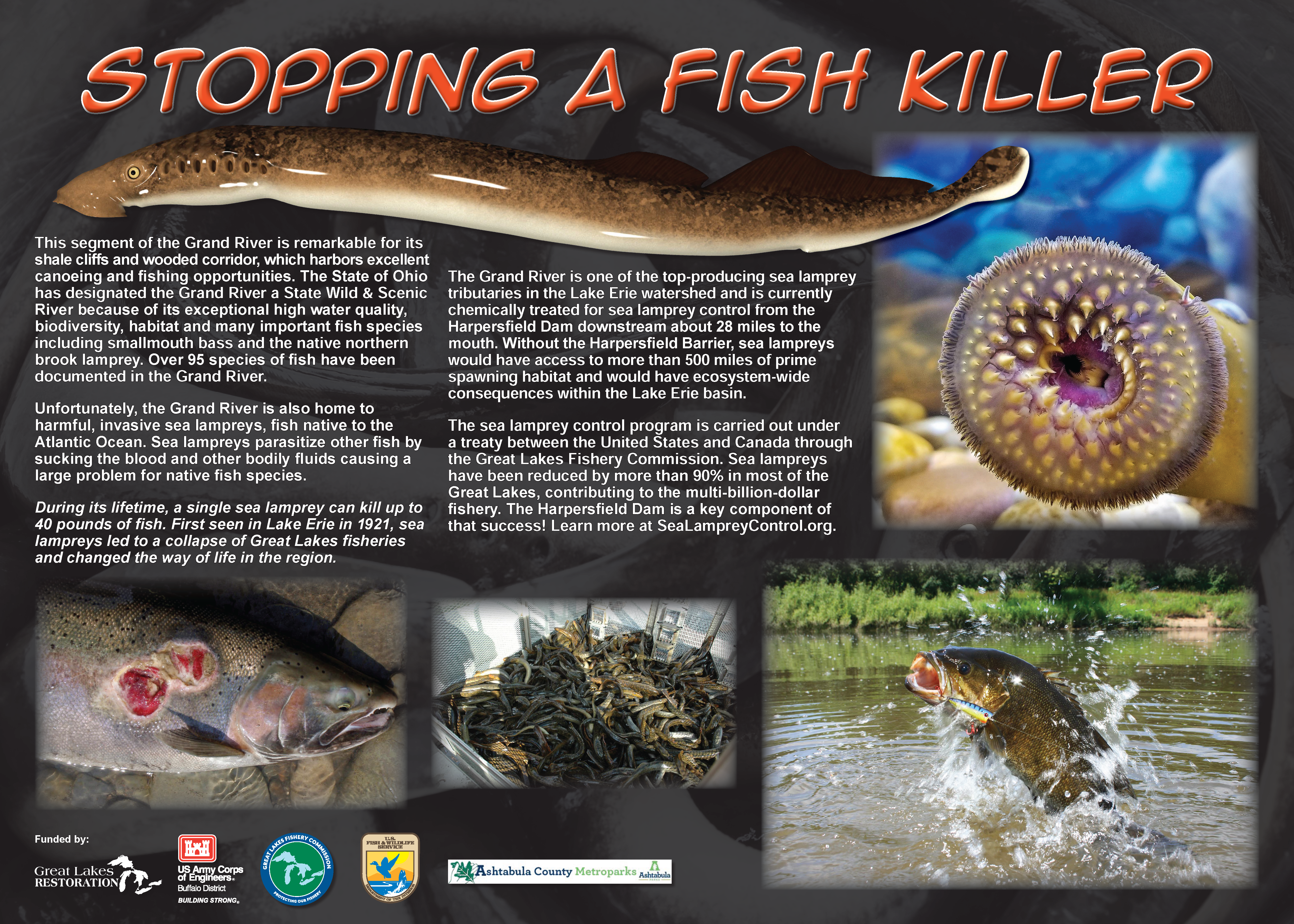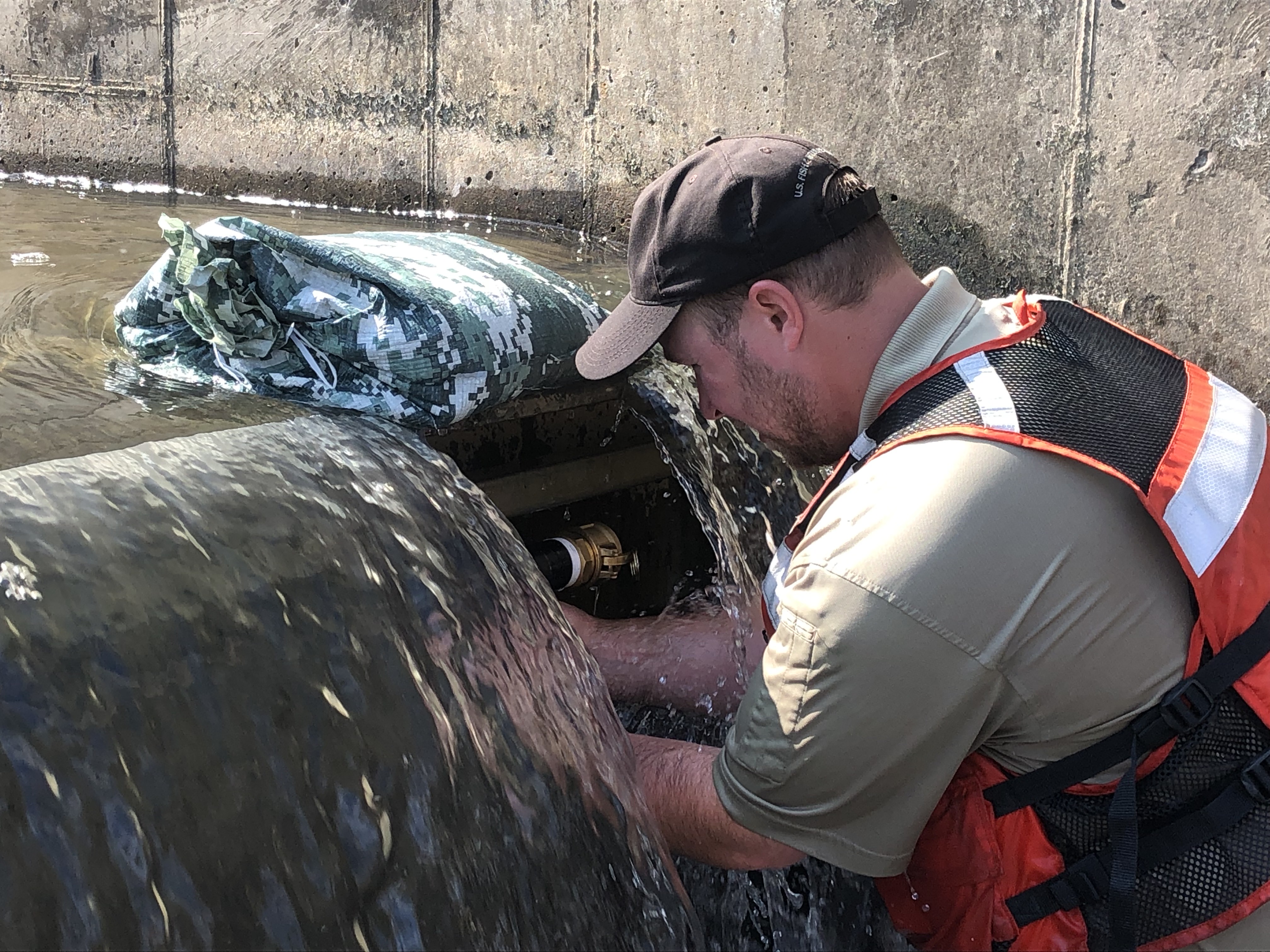Sea Lamprey Control Spreads the Distance
A new TFM delivery system has been installed at the Harpersfield Dam (Grand River, Ohio) to improve sea lamprey control!
Effective control of invasive sea lamprey populations in the Great Lakes requires constant evaluation of our current control techniques and development of new methodologies. To accomplish Sea Lamprey Control Program objectives, the Ludington and Marquette Biological Stations have been collaborating since the early 1960s. Early projects focused heavily on installation and operation of electrical and mechanical barriers and the application of selective pesticides (3-trifluoromethyl-4-nitrophenol (TFM) and Niclosamide).

An informational display at the renovated Harpersfield Dam in the Grand River (Ohio). Credit: GLFC.
Collaboration between the stations continues today with the most recent project focused on installing a permanent TFM delivery system on the Grand River (Ohio). The Grand River is a major contributor of sea lampreys to Lake Erie, requiring treatment every three to four years. The Harpersfield Dam, which was reconstructed in 2021, prevents adult sea lampreys from migrating further upstream.

An informational display at the renovated Harpersfield Dam in the Grand River (Ohio). Credit: GLFC.
With a steel lip installed across the face of the dam, staff worked together to engineer and design a TFM delivery system that would be permanently affixed to the lip which would provide a more thorough and efficient mix of TFM within the water column and decrease nontarget morality directly below the application.

FWS staff working on the new TFM delivery pipe at the Harperfield Dam in the Grand River (Ohio). Credit: FWS.
Technicians and biologists from both stations collaborated in fabricating 330 feet of steel pipe with holes drilled every 20 feet to spread TFM along the entire length of the Harpersfield Dam. Once the delivery system was tested by spreading water across the Ludington Biological Station’s parking lot, staff from both stations worked side-by-side to install the pipe during low discharge in July. The Ludington Biological Station looks forward to utilizing the TFM delivery system during the next treatment, tentatively scheduled for spring 2025.

Fish Biologist Sam Hultberg (Fish and Wildlife Service) installing the bolts into the hanger clip supporting the TFM delivery pipe at the Harpersfield Dam. Credit: FWS.
By coordinating efforts, the two stations can not only spread the distance, but also deliver a more effective program in the protection and management of a $7 billion Great Lakes fishery.
Written by Jenna Tews, Ludington Biological Station, for the Fish and Wildlife Service newsletter, Fish Lines: https://content.govdelivery.com/accounts/USDOIFWS/bulletins/3299d76. Edited by Andrea Miehls, Great Lakes Fishery Commission.
Read more Pulse on Science: Project Spotlights
- New Study Concludes Invasive Sea Lampreys Can Be Controlled by the Release of Sterilized Males
- Happy 75th anniversary to Hammond Bay Biological Station!
- Great Lakes Habitat Restoration: Partnering to Promote Fish Production
- Sea Lamprey Control Spreads the Distance
- Making the Best of a Bad Situation: Great Lakes Sea Lampreys Reveal the Origins of Vertebrate Traits
- Studying the Fish of Buffalo Reef, Traverse Bay, Lake Superior
- Doing Science is Essential...Communicating Science is Just as Critical (and maybe more FUN!)
- Faithful Fish: Walleye Show High Spawning Site Fidelity in the Great Lakes
- Finding the Sea Lamprey's Kryptonite
- Good Things Come in...Polymer Packages?
- Rambunctious Reproduction Overheard Among Great Lakes' Lake Trout
- Clearer Water Means Less Fish: Understanding How Lower Trophic Level Changes Impact Lake Huron's Fisheries

